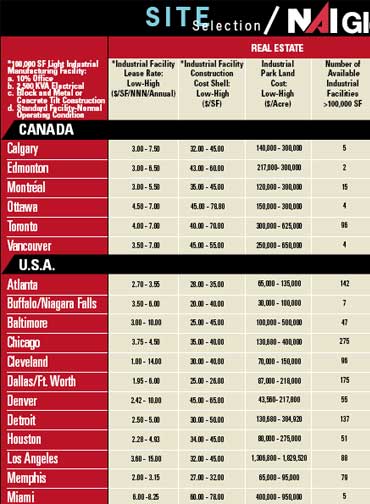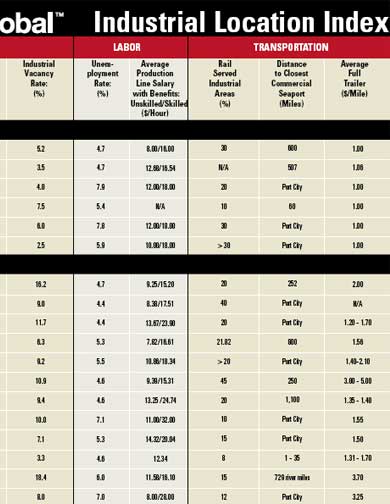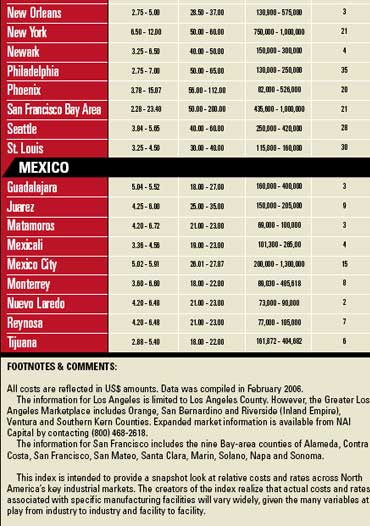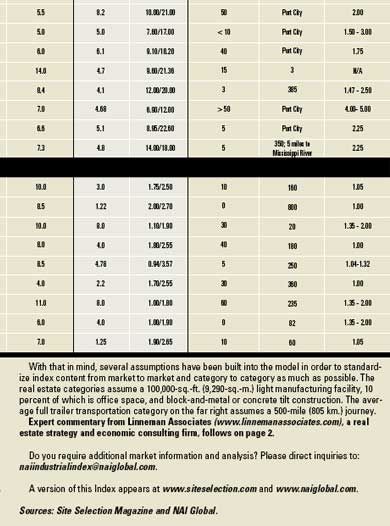Here we consider the overall economy; real estate market conditions; labor market
conditions; and transportation and logistics, to determine which markets offer the
greatest opportunity. With growing global demand for goods and cross-border commerce
on the rise, we remain bullish about the industrial sector.
Over the last year, U.S. durable goods production has risen by 6.3 percent, and
non-durable goods production continues to grow at the
sustainable rate of approximately 2.7 percent a year.
Heretofore, inventory buildups have substantially lagged
behind sales, placing a drag on warehouse demand. We
believe that the warehouse sector will finally see a long overdue improvement, as
production continues to grow and inventory levels return to traditional norms. This
vibrant activity has resulted in capacity utilization rising back to nearly 80 percent,
some 400 basis points above its cyclical low.
The majority of lease rates fall into the $3-7 (NNN) per square foot range, regardless
of national borders. In comparison to our survey six months ago, several of the
U.S. markets have experienced notable increases including: Cleveland ($1.00-
$4.50 psf vs. $1.00-$14.00 psf); Denver ($1.95-$7.00 psf vs. $2.42-$10.00 psf); Los
Angeles ($4.00-$7.00 vs. $3.60-$15.00 psf); and Miami ($4.00-$7.75 psf vs. $6.00-
$8.25). In Canada, Edmonton and Montr?al exhibited slight lease rate increases, as
did Juarez, Mexico.
From a construction cost perspective, Mexican markets are consistently lower
($18-$35 psf), in comparison to markets in Canada ($32-$78 psf) and the U.S. (most
falling in the $30-$65 psf range). In comparison to six months ago, construction
costs in Montr?al, Juarez, Nuevo Laredo, and Reynosa have edged up. In the U.S.,
Atlanta, Miami, New Orleans, Phoenix, and Seattle have also experienced rising
construction costs during that time, with Phoenix posting the largest increase ($40-
$80 psf vs. $56-112 psf).
Land costs are generally comparable across borders, with a few notable exceptions
(including Miami, Los Angeles, New York, San Francisco, Seattle, and Mexico
City). Investors often lose sight of the fact that replacement cost (at reasonable land
values) is the key to successful investing in industrial properties, as it is not a complicated
product to create or permit. Rental rates fall when markets are oversupplied,
and because of the short development cycle for industrial product, excess demand
conditions are usually short-lived. Industrial property down-cycles tend to last longer
than the up-cycles.
Using a 7-percent vacancy rate as a benchmark for
an industrial market that is “in balance”, New Orleans,
New York, Newark, San Francisco, and Seattle appear
to be in balance, while Houston and St. Louis are near
the cusp. Note that New Orleans, San Francisco, and St. Louis did not make the cut
six months ago, while Buffalo and Chicago fell out of balance over the last six
months. In Canada, only Ottawa (7.5 percent) is (slightly) above this vacancy rate
benchmark. In Mexico, only Monterrey, Reynosa and Tijuana fall below 7 percent.
Mexico City showed the greatest improvement, dropping from a 20-percent vacancy
rate six months ago to 8.5 percent today.
Turning to labor costs, Mexico holds the clear wage advantage, with average production
line wages running about $1.00-$3.50 per hour, versus about $7.00-$32.00
per hour in the U.S., and $8.00-18.00 per hour in Canada. These lower labor costs
are the main factor which makes the overall cost of doing business in Mexico significantly
lower than its northern neighbors, although some of this is offset by lower
efficiency levels.
Examining transportation, it costs about $1-$2 per mile to ship a full trailer in both
Canada and Mexico. In contrast, comparable shipping costs in the U.S. range from
$1.20 per mile to $5.00 per mile in Dallas/Ft. Worth and San Francisco. Many of the
U.S markets with higher transportation costs are port cities, while the Mexican markets
are often hundreds of miles from the nearest port. Expect oil prices to fall to
roughly $30 per barrel by 2007?s end, absent meltdowns in Saudi Arabia, Kuwait,
Russia, Iraq or Iran.
— Linneman Associates



